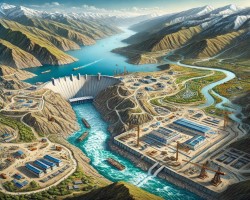China's decision to approve a $137 billion mega dam project on the Brahmaputra River near the Indian border has significant implications for geopolitics, environmental concerns, and regional water security.
Key Context
- The Brahmaputra River, known as Yarlung Tsangpo in Tibet, originates in China and flows through India and Bangladesh before emptying into the Bay of Bengal.
- The proposed dam is expected to be constructed near the Tibetan town of Medog, close to the Arunachal Pradesh border in India.
Project Details
-
Scale and Capacity:
- The dam is touted to be the world's largest hydroelectric project, surpassing the Three Gorges Dam in China.
- It is part of China's 14th Five-Year Plan (2021–2025) and aims to produce 300 billion kilowatt-hours of electricity annually.
-
Strategic Location:
- Medog is located in a seismically active zone, which raises concerns about the safety and stability of the project.
-
Timeline:
- Construction timelines and specific phases of the project have not been detailed, but it is a long-term undertaking.
Concerns for India
-
Water Security:
- The Brahmaputra is a lifeline for northeastern India. Any large-scale diversion or damming could significantly affect downstream flow, impacting agriculture, fishing, and drinking water availability.
-
Geopolitical Tensions:
- This project could exacerbate existing tensions between India and China, especially in light of their unresolved border disputes in the region.
-
Environmental Risks:
- The Brahmaputra basin is home to diverse ecosystems. The dam could disrupt natural flow, sediment deposition, and biodiversity.
- The seismically active Himalayan region poses risks of dam failure, which could lead to catastrophic downstream flooding.
-
Lack of Bilateral Mechanisms:
- India and China do not have a comprehensive water-sharing agreement. China’s control over the river’s upper reaches could create a power imbalance.
China's Stance
- Beijing claims that the dam is intended for renewable energy generation and flood control.
- Chinese authorities emphasize that the project will not significantly affect downstream flows, but such assurances are met with skepticism.
Potential Impacts
-
Economic:
- The project could boost China's renewable energy capacity, helping it meet its climate goals.
- For India, reduced river flow could harm agriculture and hydropower projects in Assam and Arunachal Pradesh.
-
Environmental:
- Alterations to the Brahmaputra’s natural flow could have transboundary ecological consequences, including in Bangladesh, which lies downstream.
-
Regional Relations:
- Bangladesh, another downstream nation, may also face reduced water availability, potentially straining its relationship with China.
India’s Response
Way Forward
-
Bilateral Agreements:
- India and China need to work toward a water-sharing treaty or memorandum of understanding to ensure equitable usage and mutual benefits.
-
Regional Cooperation:
- Collaboration among India, Bangladesh, and China is essential to manage shared river resources sustainably.
-
Environmental Assessment:
- International bodies and environmental organizations should push for thorough environmental impact assessments to mitigate risks.
Conclusion
China’s mega dam project on the Brahmaputra River highlights the urgent need for transboundary water governance in South Asia. While the project offers significant renewable energy potential for China, its downstream impacts on India and Bangladesh necessitate diplomatic engagement, strategic planning, and international cooperation to ensure equitable and sustainable water usage.
|
